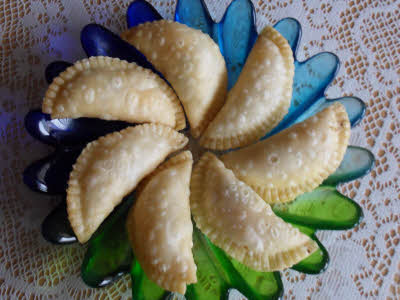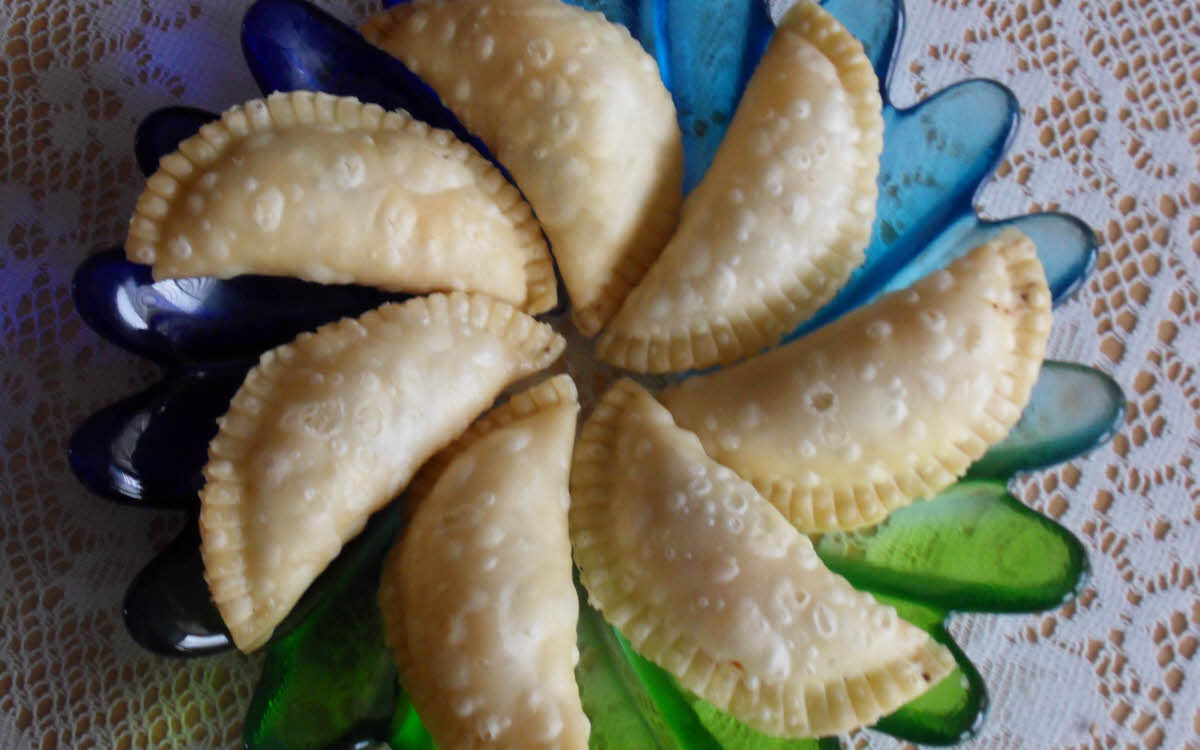This is the Uttar Pradesh style Gujia normally made on Holi. There are a lot variety available in the market but nothing compares to this one. These days, they just fill the gujia with sweet suji and dip it in sugar syrup and that tastes really heavy and too sugary. The real gujia is made with khoya filling and it is not dipped in sugar syrup.
| Preparation Time: | 30 minutes |
| Cooking Time: | 60 minutes |
| Servings: | 60 gujias |
| Difficulty: | Hard |
Ingredients
| All Purpose Flour | 500 gm |
| Ghee (clarified butter) | 100 gm |
| Water | 180 ml |
| Khoya (solidified milk) | 300 gm |
| Finely grated dry coconut | 125 gm |
| Powdered Sugar | 325 gm |
| Small cardamom (choti elaichi) | 5 |
| Kishmish (raisins) | 100 gm |
| Vegetable Oil or ghee | For frying |
Method
- In a large pan, saute khoya on medium heat.
- Once it starts leaving ghee, turn off the heat.
- Peel the elaichi/cardamom pods and grind the seeds.
- Cool off the khoya. Once it’s cold, add sugar, coconut, and cardamom powder. Mix well so that there are no lumps.
- Now add raisins to it and combine. Keep aside.
- Rub ghee in all purpose flour. The consistency should be such that if you squeeze a handful of flour in your hand and drop it in the vessel, it should keep it’s form.
- Knead it with 180 ml of water, to make a soft dough, harder than roti but softer than puri.
- Cover it and let it stand for at least 15 min. Then knead it again to make it smooth. The dough should be harder than normal roti dough. You should be able to roll it without using oil or flour without it sticking to the rolling pin.
- Divide the dough into 50 equal parts and make smooth discs.
- Mix 1 tbsp of all-purpose flour with 1/8 cup of water to make a slurry for sealing the gujias.
- Roll a disc into a thin roti.
- Place it on the gujia mold and put a spoonful of filling on it. Lightly wet the edges with the flour slurry. Now slowly close the mold to seal the filling inside the roti. Break off the extra dough. You can reuse this dough for making the next gujia.
- Remove the gujia from the mold and keep between the layers of a moist muslin cloth. Make sure that the ends of gujia are properly sealed by pressing it gently on the seams. Repeat with rest of the dough.
- Heat oil in a wok. To test it, drop a pea-sized dough in the wok. If it sizzles too much or browns immediately, the oil is too hot. If it does not sizzle at all, the oil is not hot enough.
- Once the oil is hot enough, keep it at medium heat. The gujias are fried on lower heat to achieve the crispness.
- Slowly drop a few gujias in the oil and fry for a few minutes till they start to change color but not turn brown. Do not turn them over too much, they might break.
- Drain them on a paper towel so that excess oil is absorbed by the paper.
- Let them cool off and then store them in an airtight container. These gujias can last in the pantry for at least 3 weeks if they are not finished.
Notes
- While dropping gujias in oil, make sure that the ends are sealed. If they are not properly sealed, all the filling will come out in the oil and the oil will become blackish, which will make rest of the gujias blackish too. So keep an eye on gujias while they are frying, as soon as any filling starts to come out, immediately remove the gujia from the oil.
- If you don’t have the gujia mold, you can seal the gujia with the help of water and flour and then use pastry cutter to cut off the edges.
- Make sure that the coconut is not stale because that spoils the whole taste.
- If you fill too much filling in the shell, it will be hard to seal the gujia and then it will come out while frying. So if gujias are opening up while frying, try reducing the filling.
Summary

Recipe Name
Gujia
Author Name
Ruchi Garg
Published On
Total Time
Average Rating




 Based on 3 Review(s)
Based on 3 Review(s)









